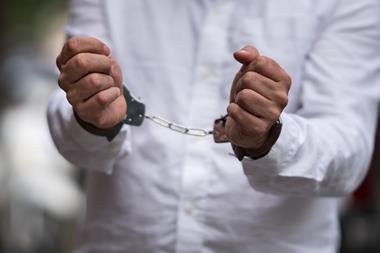Ghost broking is a growing problem for insurers and law enforcement. It’s the tip of an iceberg of major organised crime
The Cotswolds village of Brimpsfield isn’t the kind of place normally associated with insurance fraud. But policy documents suddenly started flooding through the letter box of one of the village’s larger homes.
Puzzled, the householder sought clarification from the insurance companies which had sent out the documents. Finding none, he threw a bunch of the documents onto a fire.
What the insurance companies didn’t realise was that the householder had unwittingly been entangled in a ghost broking fraud.

“The policies had all been incepted by a ghost broker using this address,” says Paul Holmes, insurance partner at solicitors DWF, who dealt with the case.
The penny dropped when several of the man’s neighbours also found themselves being bombarded with policy documents.
Even the local postman became concerned about the volume of insurance correspondence being sent to the village, says Holmes.
The ghost brokers had chosen the Cotswold village because it is a very low risk address with consequently rock bottom premiums. By using addresses in the village to incept fake policies, the ghost brokers were able to secure massive discounts for their customers.
Once a fraud like this has been committed, it is difficult to shake off, says Holmes: “If someone committed fraud at an address, they will have a footprint even though they’ve never lived there.”
Ghost broking is increasingly on the agenda for insurance companies.
“All the main insurers are talking about ghost broking as one of their main concerns,” says detective chief inspector Andy Fyfe, head of the City of London Police’s Insurance Fraud Enforcement Department (IFED).
Between November 2014 and October 2017, the department’s Action Fraud centre received more than 850 reports nationwide linked to ghost broking, with reported losses for both individuals and organisations totalling £631,000. Each individual victim lost an average £769, according to IFED.
Steve Jackson, head of financial crime at Covéa Insurance, agrees that ghost broking is a “large and growing problem”.
Ben Fletcher, director of the Insurance Fraud Bureau (IFB), says that just under one third of the approximately 200 cases that the organisation is currently investigating relate to either ghost broking or application fraud.
The number of requests that the IFB receives from insurers to help investigate ghost broking fraud is up a “relatively modest” 6% on last year, he says.
But the number has grown significantly since five years ago when “hardly any” of the cases handled by the industry-funded organisation involved ghost brokers.
Chris Hallett, insurance product manager at Synectics, says the company’s data matching service SIRA has seen a 600% increase in the number of cases marked as impersonation fraud in its database over the last year.
This increased volume of reported impersonation scams, which anti-fraud practitioners say are often closely linked to ghost broking, is partly down to greater awareness of the problem, acknowledges Hallett. “We’ve made it easier to mark cases and the industry is more alive to it.”
And each ghost broking case can have far-reaching ramifications.
Jackson was told by one of the larger brokers that it is having to cancel 190 policies a week, which have been set up by ghost brokers. If each of these involves an average loss of £1,000, that works out at around £10m per annum from just one intermediary, he estimates.
Organised crime
And it’s not just a headache for the insurance industry. There are well-documented connections between ghost broking and serious organised crime.
Operation Ludlow, which resulted in eight individuals being sentenced last November for a total of 23 years and eight months, uncovered links between ghost broking offences and human trafficking, says Fletcher: “This is criminality of the most serious level.”
Jackson says that during one investigation, he saw that the same gang, which had been involved in a ghost broking scam, had also been looking at websites for buying guns.
Fake motortrade policies, which are usually arranged by a ghost broker, are particularly popular amongst organised criminals because it enables them to run large numbers of vehicles with less risk of being pulled over by the police.
“They are laid on by bogus brokers to keep the police at bay,” says Fyfe.

According to a tech source, one insurer has given up writing motor trade policies because of how widely they are being abused.
Fletcher says ghost broking started out as a “cottage industry”, often undertaken by individuals who were gaming the insurance system for the benefit of their friends and family.
However, he says, ghost broking is increasingly being carried out on an “industrial scale”.
Claims scams
Investigators also report ghost brokers setting up fake policies for the purpose of lodging false claims.
The rise of ghost broking can partly be explained by the industry’s crackdown on claims fraud, which has prompted some of those involved in such scams to look for fresh money-making opportunities.
And the returns from application fraud can be near instantaneous, says Fletcher: “Fraudsters will go wherever they make money most quickly. The attraction of ghost broking fraud is how quickly they can realise their money.
“With a personal injury claim, committing the fraud to getting the cash is going to take weeks if not months, whereas if you are a ghost broker you can probably start generating cash in hours if not sooner.”
And it’s a relatively low risk activity, says IFED’s Fyfe: “It’s quite easy to set yourself up with a website purporting to be a main insurer or using social media to approach people appearing to offer easy or cheaper insurance than anyone else can achieve.
“People who come to the UK who are not familiar with the way the market works can be easily taken in and find themselves with invalid insurance.”
The increasingly transient nature of the UK population, partly due to the decline of home ownership and growing immigration, also makes insurers’ lives harder, Holmes says: “It’s more difficult to verify people because they haven’t lived in one place for a long time.”
Demand for ghost brokers’ services is also being fuelled by the industry’s clampdown on uninsured drivers. Thanks to ANPR cameras, it is now much easier to catch those who are driving without insurance.
Fletcher says: “Peoples’ prime motivation to go to a ghost broker is to avoid being caught for having no insurance. If your vehicle is not insured the police will be able to tell instantly.”
By obtaining a policy from a ghost broker, the customer will be able to get their vehicle entered on the MID (Motor Insurance Database).
And by going to a ghost broker, higher risk drivers will be able to secure cover much cheaper than through legitimate channels, says Fletcher: “If the insurance company had been told the true facts of the policy, they would have charged a materially different premium or wouldn’t have offered the cover in the first place.”
Technology helps the scammers
Technology facilitates the scams, he adds: “In the old high street broker model, the ghost broker wouldn’t be able to operate.”
While some ghost brokers still work word of mouth, fraudsters also find customers by advertising either in the classified ads in local papers or on social media, typically only including a first name and telephone number.
Social media has proved a particular boon for ghost brokers because it provides them with an easy way to advertise and cover their tracks, says Holmes. Some will offer fake insurance policies alongside equally bogus disabled badges and driving licences.
However, trying to put the technological genie back in the bottle is clearly a non-starter. So what can insurers do to stem the tide of ghost broking?
Some bogus applications will be picked up when insurers will of course automatically check against various data bases, says Holmes: “At policy validation checks it will quickly transpire that the name and address doesn’t match up.”
Fletcher says that insurers are sharing data about ghost broking, while IFED’s campaigns and investigations have raised awareness of the problem.
Often though, fake policies will only be found out when an accident happens or if the policy holder is stopped by the police or a claim is submitted, at which point the insurer will void them.
Jackson says that sophisticated tools are available, which can identify the unique footprint of up to 90% of internet users based on factors such as the language and software they use and how their keyboard is set up.
However, aside from the expense involved, using such sophisticated analytics often means having a real time online interaction with the suspected ghost broker.
Some of the solutions are more low tech. Insurers should be more nimble about how they verify customers’ ID rather than relying on the hoary list of first line of address, postcode and mother’s maiden name, argues Hallett.
Ghost brokers are often able to bypass such questions by looking at Facebook, he says: “It needs to change: it has to be something that can’t be found out on social media.”
He says that companies could use voice ID verification, or face recognition software by making the customer take a selfie on their phone.
Holmes says that some insurers are insisting, when dealing with brokers, that an image of the customer’s driving license is uploaded or physically sent to the broker within a certain number of days.
Some of the smaller insurers tend to take this very strict approach, he says: “When dealing with hundreds of thousands of policies that becomes very difficult to administer.”
The pressure to arrange motor cover rapidly leaves insurers open to abuse, he adds: “You are dealing with a product where by necessity the customer needs to be able to incept and obtain a policy quickly.
“If you have extremely strict ID criteria, many people simply couldn’t get insurance. It’s not like opening a bank account where somebody has to produce formal ID. It would be impossible for the motor market to operate like that.”
Any insurer that takes such a strict approach risks seeing their share of a fiercely competitive market become eroded.
The introduction of the Mylicence initiative will help, because it will provide insurers with more driving history information, says Fletcher: “The ability of the ghost broker to lie about your driving history and where you live is going to be limited.”
DVLA is the key
But the big ask from the industry is easier sharing of DVLA registration information with insurers.
“Where an insurer has a policy that they suspect has been submitted by a ghost broker often the only true detail they have is the vehicle registration number and they don’t have a way to contact the owner of the vehicle,” says Fletcher.
“At the moment insurers are struggling because they don’t have the information they need. If they have access to data from the DVLA, they could manage that process far better.”
The police have powers to obtain this information but with resources so stretched they will generally want a firm lead before making such a request, says Covéa’s Jackson: “They will support us but they need a starting point to take an interest. You can’t depend on the police to do all the research.”
Creating an industry-wide benchmark for insurance fraud investigators could provide the DVLA with greater confidence to share information, he suggests.
“We can raise the standards so people see these are recognised criminal investigators. It means that organisations like DVLA can see that the person is accredited to an industry standard.”
These may look like small changes but they could make a big difference in tackling the ghost broking scourge.






































No comments yet